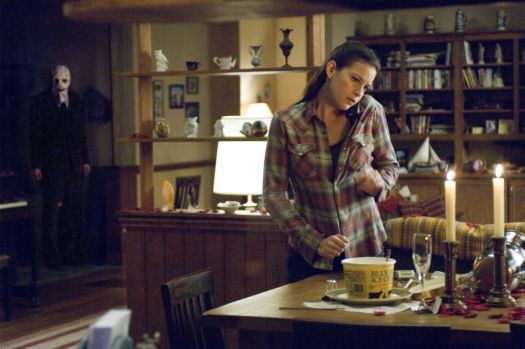
Fright Week 2013: Leaving the Lights on…Permanently: The Strangers
Written by: Meaghan Clohessy, Special to CC2K
For CC2K’s Fright Week, here is The Moviola’s own Meaghan Clohessy on Bryan Bertino’s The Strangers.
Audiences look for the safety nets in horror films. The use of daylight, heightened musical tones, and telling dialogue has all been used to warn of impending dangers. This way, audiences have a system of defense against the film. Stripped of such safety nets is Bryan Bertino’s 2008 film The Strangers. The film centers on James Hoyt (Scott Speedman) and Kristen McKay (Liv Tyler), a couple spending a night at the Hoyt family cabin after a wedding reception. Soon afterward, they are stalked and tortured by a family of masked killers. Using technical mastery to achieve a disconcerting realism, The Strangers is a film that gets under the skin. No safety net can protect audiences from the horror onscreen.
In the short time of an hour and twenty-six minutes, The Strangers follows a standard narrative arch. There are clear-cut transitions from exposition to complication, from complication to rising action, and so on. Bertino marks these transitions through tension. For each segment of the narrative arc, there is a different tension. In the expositional segment, the tension lies in the fragile relationship of James and Kristen following a failed marriage proposal. When the Strangers start to appear at the cabin, tension switches from the relationship to home invasion. Tension is not only effective for placing audiences within the narrative arc, but also it keeps them disconcerted. If tension is consistently monothematic it becomes easier for audiences to simply get used to it. By constantly changing the root of tension, audiences are never allowed to get comfortable.

No, just…no.
What is disturbing about this film is its stark realism. This realism is accomplished through cinematography and musical direction. Concerning cinematography, camera movements are often shaky. This technical choice removes a crucial layer of defense between audiences and the film. The unstable camera movements create a documentary-like atmosphere, transplanting audiences into the scene. Wide camera shots capture the total isolation that surrounds the Hoyt family cabin, shaping nature to become as hostile as the Strangers. Coupled with cinematography is musical direction.
Bertino has a mastery of utilizing music, particularly when not to use it. Background noise is kept to a minimum, with some moments of the film conducted in complete silence. A prominent example of this technique—and the scariest moment of the film—its where Kristen is alone in the cabin and one of the Strangers appears behind her. The Stranger is distant in the shot; without music, he is easily missed as he stares at Kristen for several agonizing seconds. Then there’s the record player that only seems to play creepy country music. When that music starts to skip as the Strangers enter the house, I have to employ some major self-discipline to keep from digging my nails into my arms.
With simple technical strategies, the film is able to take basic fears of isolation, invasion, and claustrophobia and make them absolutely terrifying. In that respect, The Strangers is an organic horror film, unobstructed by needless gore.
 Um, hey someone’s…nevermind.
Um, hey someone’s…nevermind.
An interesting element of the film that often goes overlooked is the comment of gender stereotypes. During the expositional segment of the film where James and Kristen express their feelings toward a broken relationship, both express reactions that would be considered stereotypes of the opposite gender: James digs into a tub of ice cream while Kristen drinks a Corona. There is also a moment where James takes off Kristen’s necklace so she can take a bath. In most films, a man placing a necklace on a woman signifies ownership. This reversal suggests a break from common patriarchal norms. Where James and Kristen break from these norms, the Strangers act to uphold conservative notions of gender. Their clothing and mannerisms are that of a typical family, with the father at the helm and wife and daughter at the rear. When they finally capture James and Kristen, the Strangers force them to dress in the apparel they wore for their friend’s wedding. The couple’s death then becomes a way for the Strangers to uphold conservative notions of gender and the family structure. The commentary is subtle, but success of this film relies on its subtlety.
There is no doubt that The Strangers is one of the best horror films in the last five years. If a film makes you afraid of daylight, you know it’s good.
